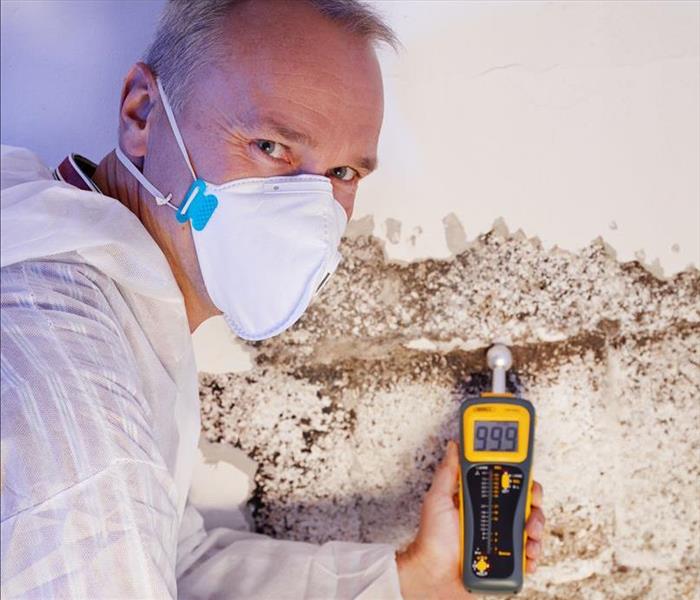A Brief Guide to Mold in the Workplace
5/26/2015 (Permalink)
 Have professionals test if you suspect that you have mold damage in your commercial office. If mold exists they can create a remediation plan.
Have professionals test if you suspect that you have mold damage in your commercial office. If mold exists they can create a remediation plan.
General public awareness has been greatly increased in the past years about just how dangerous indoor mold can be to a person's health and a building's structure. What we'll be discussing here is some safety tips and information about keeping mold out of larger office buildings and just what to do if there is a mold outbreak. This will assist those responsible in creating and evaluating their remediation plans and help them respond as quickly and as knowledgably as possible. That being said, the information here is just a quick summary and should not be looked upon as the end all, be all of indoor office mold information.
First, let's take a look and see just what mold is.
The Basics of Mold
Molds are a natural part of the environment and can be found virtually anywhere, including outdoor and indoor environments, all throughout the year. Currently, there are around 1,000 species of mold native to the United States with about 100,000 known species across the globe.
Mold plays an important part in the environment outside. It helps break down just about any type of organic matter, such as fallen leaves, dead animals, and dead trees. For us, it also allows us to make things such as penicillin and cheese.
While mold does have its benefits in general, it's never a good thing to have growing inside homes or offices. Indoor mold can cause major problems, as it can eat away at the foundation, the inside decorations, and can even cause health problems to people.
It can grow on virtually anything, as long as the mold has some water, oxygen, and some organic compound to eat. When it has those things, it also spreads rapidly, given its airborne spore-centered method of reproduction.
It's very easy for mold to grow anywhere that moisture is present. The longer the mold goes untreated, the more problems it can cause. Some types of mold prefer growing on wood, insulation, food, carpet, or paper products, but it's even possible for some types to spread simply by eating dust.
One of the problems is that it doesn't need sunlight to grow, which means that mold that's nested in areas that can't be seen, such as under floorboards.
Mold Prevention Tips
Now that we understand a little bit about what mold is, let's take a look and see how to reduce the chances it has for growing in your workplace.
How Do I Know If I Already Have Mold?
Prevention is great, but sometimes mold can still sneak in through the cracks. Let's take a look at some ways to see how to determine if your workplace is already experiencing mold.
Mold Cleanup Methods
If you do find that mold is present, the correct method for cleanup would be to remove any causes of moisture and to completely remove the contaminated materials to prevent any further damage. There are a number of different cleaning methods you can employ to help remediate the damage mold causes. The specific method you employ for your workplace will depend on specifically what type of material has been affected.
Wet Vacuum
These are vacuums that are specifically designed to pick up water, whether the water is standing on hardwood floors, carpeting, or pooled in one area. Wet vacuums should not be used on porous material like gypsum board and should only be used on particularly wet materials. After using the device, make sure to clean and dry thoroughly to prevent mold buildup in the machine itself.
Water and Detergent
For nonporous material, mold can quickly be cleaned by using a combination of water and detergent. Make sure to dry thoroughly after wiping down the area.
High-Efficiency Particulate Air Vacuums
HEPA vacuums are great to use after an area has already been cleaned using traditional methods and considerably dried. Ensure that the filter is properly fitted into the machine and that anyone operating it uses a mask when switching filters.
While mold is a huge nuisance, particularly in larger office areas, it's important to remain proactive to ensure that there isn't any chance for it to develop. In addition to that, maintain regular contact with the building's occupants to be able to respond quickly and effectively in case mold gets through anyway.
SERVPRO of Coon Rapids responds quickly to your Coon Rapids fire, water, or mold damage emergency, 24 hours a day. Whether the damage occurs in a small business building or a big box store, we have the training, experience, and equipment to handle the situation. Our technicians are highly trained in business mold removal, business mold remediation, commercial mold removal, remove business mold, serv pro cleaners, and disaster restoration services.
Have Questions? Call Today – (763) 712-9712
Locally Owned Company with National Resources
SERVPRO of Coon Rapids/Central Anoka County is locally owned and operated—so we live and work here too and are proud to be part of this community.






 24/7 Emergency Service
24/7 Emergency Service